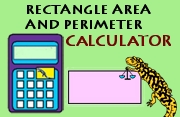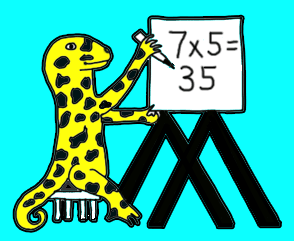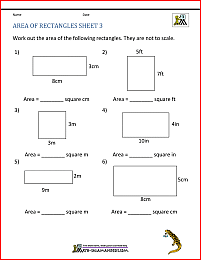- Home |
- About |
- Contact Us |
- Privacy |
- Newsletter |
- Shop |
- Donate
Rectangle Area and Perimeter Calculator

Welcome to our Rectangle Area and Perimeter Calculator page.
We explain how to find the area and perimeter of a rectangle and provide a quick calculator to work them out for you, step-by-step.
There are also some worked examples and links to some worksheets where you can practice this skill.
Quicklinks to ...
Rectangle Area and Perimeter Calculator
This calculator finds the area and perimeter of a rectangle when the side lengths are known.
- Choose the length and width of the rectangle: you can choose a whole number, decimal or fraction.
- You can type a fraction by typing the numerator then '/' then the denominator.
- You can type a mixed number by typing the whole-number part, then a space then the fraction part.
- Examples: 2 1/2 (two and one-half); 3 4/5 (three and four-fifths); 7 1/3 (seven and one-third).
- Choose your units of measurement (default is none)
- Choose your desired accuracy (default is 2 decimal places)
- Click the Find Area & Perimeter button
- You will be shown the area and perimeter as a decimal (and also a fraction if you typed the length as a fraction).
What is a Rectangle?

- A rectangle is a quadrilateral (4-sided shape) with 4 right angles.
- Every rectangle has opposite sides of equal length.
- If the sides are all the same length, then you have a special case of a rectangle called a square.
What is the Area and Perimeter of a Rectangle?

The area of a rectangle is the amount of space inside the rectangle.
The perimeter of a rectangle is the distance around the outside edge of the rectangle.
Area and Perimeter of a Rectangle Formula

The formula for the area of a rectangle is: \[ A = l \times w \; \]
where l is the length and w is the width of the rectangle
The formula for the perimeter of a rectangle is: \[ P = 2l + 2w \; or \; 2 (l + w) \]
where l is the length and w is the width of the rectangle
Area and Perimeter of a Rectangle Examples
Area and Perimeter of a Rectangle Example 1
Find the area and perimeter of the rectangle below.

The length of rectangle is 12 cm and the width is 7 cm.
The area of a rectangle
\[ A = l \times w \; \] where l is the length and w is the width of the rectangle.
So if we substitute the values of the length and width into this equation, we get: \[ A = 12 \times 7 = 84 \]
The area of the rectangle is 84 cm2.
The perimeter of a rectangle
\[ P = 2l + 2w \; \]
So if we substitute the values of the length and width into this equation, we get: \[ P = (2 \times 12) + (2 \times 7) = 24 + 14 = 38 \]
The perimeter of the rectangle is 38 cm.
Area and Perimeter of a Rectangle Example 2
Find the area and perimeter of the rectangle below.

The length of rectangle is 2.4 m and the width is 0.7 m.
The area of a rectangle
\[ A = l \times w \; \] where l is the length and w is the width of the rectangle.
So if we substitute the values of the length and width into this equation, we get: \[ A = 2.4 \times 0.7 = 1.68 \]
The area of the rectangle is 1.68 m2.
The perimeter of a rectangle
\[ P = 2(l + w) \; \]
So if we substitute the values of the length and width into this equation, we get: \[ P = 2 \times (2.4 + 0.7) = 2 \times 3.1 = 6.2 \]
The perimeter of the rectangle is 6.2 m.
Area and Perimeter of a Rectangle Example 3
Find the area and perimeter of the rectangle below leaving your answer for the area as a mixed fraction.

Although this shape is tilted, it is still a rectangle.
The length of rectangle is 3 ½ inches and the width is 8 ½ inches.
The area of a rectangle
\[ A = l \times w \; \] where l is the length and w is the width of the rectangle.
So if we substitute the values of the length and width into this equation, we get: \[ A = 3 {1 \over 2} \times 8 {1 \over 2} = {7 \over 2} \times {17 \over 2} \]
Multiplying the fractions together gives us: \[ A = {7 \times 17 \over 2 \times 2} = {119 \over 4} = 29 {3 \over 4} \]
The area of the rectangle is 29 ¾ in2.
The perimeter of a rectangle
\[ P = 2(l + w) \; \]
So if we substitute the values of the length and width into this equation, we get: \[ P = 2 \times (3 {1 \over 2} + 8 {1 \over 2}) = 2 \times 12 = 24 \]
The perimeter of the rectangle is 24 inches.
Area and Perimeter of a Rectangle Example 4
Find the area and perimeter of the rectangle below. Give your answer in cm or cm2.

The length of rectangle is 2.1 m and the width is 45 cm.
First we need to convert 2.1 m into cm so that both measurements have the same units of measure.
1 m = 100 cm so 2.1 m = 2.1 x 100 = 210 cm
The area of a rectangle
\[ A = l \times w \; \] where l is the length and w is the width of the rectangle.
So if we substitute the values of the length and width into this equation, we get: \[ A = 210 \times 45 = 9450 \]
The area of the rectangle is 9450 cm2.
The perimeter of a rectangle
\[ P = 2(l + w) \; \]
So if we substitute the values of the length and width into this equation, we get: \[ P = 2 \times (210 + 45) = 2 \times 255 = 510 \]
The perimeter of the rectangle is 510 cm.
You can use our Rectangle area and perimeter calculator to check any of these examples out!
Related Area and Perimeter of a Rectangle Questions
How do you find the maximum area of a rectangle when the perimeter is fixed?
An example of this type of problem might be if we have a fence of a particular length and we want to enclosed the maximum rectangular space inside it.
It turns out that to get the largest area for a rectangle with a fixed perimeter is to make a square shape with equal sides.
If you look at the table below, you can see 3 rectangles, each with a perimeter of 12 cm.

- The rectangle with the largest area is the square with an area of 9 cm2.
As the difference between the two adjacent sides of the rectangles become closer in value, the amount of space inside the rectangle increases.
As the difference between the two adjacent sides becomes greater, the amount of space inside the rectangle decreases.
This means that if we have a fixed perimeter, then to get the greatest area we need to divide the perimeter by 4 to get the length of each side of the square.
How do you find the length and width of a rectangle if you know the area and perimeter?
Sometimes, we know the area and perimeter of the rectangle but we need to find the length of the sides.
The formula for this is quite tricky. If you know that the lengths of the sides are integers, then Method 1) might be the easiest way to do this.
If you are confident using formulas or the side lengths have decimal or fractional values, then Method 2) will be better.
Method 1) Using factor pairs
Write down all the factor pairs that multiply together to make the area value.
Once you have written down the factor pairs, you can see if they make the correct perimeter by doubling the total of the pairs.
Example: A rectangle has an area of 36cm2 and a perimeter of 26 cm.
What are the lengths of the two adjacent sides?
Factor pairs which multiply together to make 36 are:
- 1 and 36
- 2 and 18
- 3 and 12
- 4 and 9
- 6 and 6
The factor pairs represent the possibilities for the lengths of the two sides.
Now if we work out the perimeter of these pairs
- 1 and 36. Perimeter = 2 x (1 + 36) = 2 x 37 = 74 cm
- 2 and 18. Perimeter = 2 x (2 + 18) = 2 x 20 = 40 cm
- 3 and 12. Perimeter = 2 x (3 + 12) = 2 x 15 = 30 cm
- 4 and 9. Perimeter = 2 x (4 + 9) = 2 x 13 = 26 cm
- 6 and 6. Perimeter = 2 x (6 + 6) = 2 x 12 = 24 cm
The rectangle we need is the one with sides 4 cm and 9 cm long which have an area of 36 cm2 and a perimeter of 26 cm.
Method 2) Using the formula
Alternatively, you can use the formula which is outlined below.
We know that \[ A = l \times w \] \[ P = 2(l + w) \]
If we rewrite the equations and substitute the new values into the equations, this gives us a formula for finding the length of the two sides.
The formula for finding the two sides is: \[ lengths = {P \over 4} \pm \sqrt{{P^2 \over 16} - A } \] this gives us both values of the two adjacent sides because of the plus/minus sign.
We can split this formula up into two separate formulas for each of the sides: \[ l = {P \over 4} + \sqrt{{P^2 \over 16} - A } \] \[w = {P \over 4} - \sqrt{{P^2 \over 16} - A } \] where l is the longer side of the rectangle and w is the shorter side
Example: A rectangle has an area of 21.7 cm and a perimeter of 19.4 cm.
What are the lengths of the sides?
Using the formula gives us: \[ lengths = {19.4 \over 4} \pm \sqrt{{19.4^2 \over 16} - 21.7} \] Simpliying this gives us: \[ lengths = 4.85 \pm \sqrt{23.5225 - 21.7} \] which means that \[ lengths = 4.85 \pm \sqrt {1.8225} = 4.85 \pm 1.35 \]
So the rectangle has a longer side of 4.85 + 1.35 = 6.2 cm
and a shorter side of 4.85 - 1.35 = 2.5 cm
More Area & Perimeter Support and Resources
We have a range of other area worksheets and support pages for a range of different 2d shapes.
More Area & Volume Calculators
We have a range of area and volume calculators to help you find the area and volumes of a range of different 2d and 3d shapes.
Each calculator page comes with worked examples, formulas and practice worksheets.
How to Print or Save these sheets 🖶
Need help with printing or saving?
Follow these 3 steps to get your worksheets printed perfectly!
How to Print or Save these sheets 🖶
Need help with printing or saving?
Follow these 3 steps to get your worksheets printed perfectly!
Subscribe to Math Salamanders News
Sign up for our newsletter and get free math support delivered to your inbox each month. Free seasonal math grab pack included.
Return to Calculators Hub page
Return from Rectangle Area and Perimeter Calculator to Math Salamanders Homepage
Math-Salamanders.com

The Math Salamanders hope you enjoy using these free printable Math worksheets and all our other Math games and resources.
We welcome any comments about our site or worksheets on the Facebook comments box at the bottom of every page.








New! Comments
Have your say about the Math resources on this page! Leave me a comment in the box below.